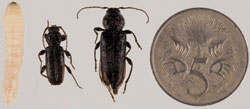
European House Borer

European House Borer (EHB), Hylotrupes bajulus (L.) is a destructive longicorn beetle pest of timber, attacking seasoned untreated softwood timber including pine, fir and spruces. It can infest furniture, structural timber in buildings as well as dead parts of pine trees.
Its current distribution includes Europe, Africa, North and South America, the Middle East and Australia, where it was first found in Perth’s eastern suburbs in January 2004 and an eradication program ensued.
In 2010 a determination was made that it was not technically feasible to eradicate EHB from Western Australia and the eradication program has moved into a management program phase.
Notifiable status
European House Borer (Hylotrupes bajulus) is not a notifiable plant pest in NSW.
However, if you suspect European House Borer:
- Call the Exotic Plant Pest Hotline 1800 084 881
- Email biosecurity@dpi.nsw.gov.au with a clear photo and your contact details
A full list of notifiable plant pests and diseases can be found in Schedule 2 of the NSW Biosecurity Act 2015.
Look out for European House Borer
A national publication (PDF, 142.07 KB) developed as part of the national management plan on EHB
What’s the threat to NSW?
NSW is currently free of EHB.
The most likely pathway of entry of EHB into NSW is by the movement of undetected larvae in infested seasoned pinewood.
EHB larvae are difficult to detect in infested wood. The appearance of emergence holes of the adult beetle is usually the first indication that EHB is present in timber. From a surveillance standpoint, detection at this stage may be too late as damage to the timber has already been done by the larva and the adult may have moved off to mate and infest new timber.
If EHB is introduced to NSW and goes undetected, it may establish and not be eradicable.
What to look for
EHB can be been found in dead sections of live pine trees, dead pinewood material and in structural timber in roof trusses.
Oval shaped emergence holes – (5-10 mm wide) running with the grain of infested timber from which the adult beetle has emerged.
Note: other pest beetles also have oval shaped emergence holes but these will typically be found running across the grain.
Frass – this is the droppings of the EHB larvae mixed with fine wood dust. Frass is often found on the ground just below where the adult beetle has emerged.
Blisters – long blister-like swellings under the surface of a thin layer of uneaten wood where the borer has eaten a gallery (tunnel) through the wood and tightly packed it with frass (droppings).
Adult beetles – are brownish-black to black in colour and have a slightly flattened appearance. Beetle wings are usually all black and may have distinctive white patches. The top surface of the first body segment behind the head has two raised, black shiny knobs; two of these are like
eyes. Adults are about 18-25 mm in length with antennae that are about half as long as the body.
EHB Larvae – larvae are rarely seen as they are hidden in the timber. They are a creamy white colour with a rippled body an enlarged flattened head. At maturity larvae can be up to 40mm in length and 7.5 mm wide.
A soft scraping sound – this is made by the larvae as they feed and may be heard most clearly at night.
Legislation
The Biosecurity Regulation 2017 under the Biosecurity Act 2015 regulates the importation, introduction and bringing of European house borer (EHB) host material into New South Wales that is likely to introduce the pest European house borer (Hylotrypes bajulus).

